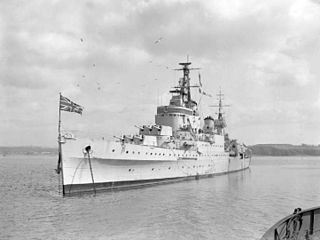
The seventh HMS Newcastle was a member of the Southampton subclass of the Town-class light cruiser of the Royal Navy.

Mahan-class destroyers of the United States Navy were a series of 18 destroyers of which the first 16 were laid down in 1934. The last two of the 18, Dunlap and Fanning, are sometimes considered a separate ship class. All 18 were commissioned in 1936 and 1937. Mahan was the lead ship, named for Rear Admiral Alfred Thayer Mahan, an influential historian and theorist on sea power.
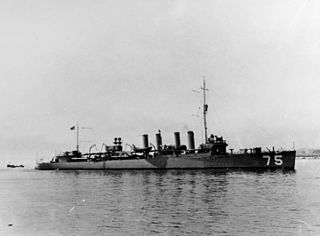
The first USS Wickes (DD-75) was the lead ship of her class of destroyers in the United States Navy during World War I, later transferred to the Royal Navy as HMS Montgomery. She has been the only ship of the Royal Navy to bear the name Montgomery.

USS Fairfax (DD-93) was a Wickes-class destroyer in the United States Navy during World War I, later transferred for World War II service first to the Royal Navy as HMS Richmond (G88), a Town-class destroyer, and then to the Soviet Navy as Zhivuchy.

The first USS Twiggs (DD–127) was a Wickes-class destroyer in the United States Navy during World War I. She was named for Major Levi Twiggs. She was later transferred to the Royal Navy, as HMS Leamington and to the Soviet Navy as Zhguchy, before returning to Britain to star in the film The Gift Horse, which depicts the St. Nazaire Raid.

USS Tarbell (DD–142) was a Wickes-class destroyer in the United States Navy during World War I. She was the first ship named for Captain Joseph Tarbell.

USS Du Pont (DD–152) was a Wickes-class destroyer in the United States Navy during World War II, later reclassified as AG-80. She was the second ship named for Rear Admiral Samuel Francis Du Pont.

The first USS Haraden (DD–183) was a Wickes-class destroyer in the United States Navy in the period following World War I. She was later transferred to the Royal Canadian Navy as HMCS Columbia, as a Town-class destroyer.

USS Burrows (DD-29) was a modified Paulding-class destroyer in the United States Navy during World War I and later in the United States Coast Guard, designated (CG-10). She was the second ship named for Lieutenant William Ward Burrows II.

The first USS Ammen (DD-35) was a Paulding-class destroyer in the United States Navy during World War I and later in the United States Coast Guard, designated as CG-8. She was named for Rear Admiral Daniel Ammen.
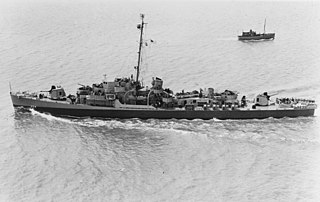
USS Rudderow (DE-224) was the lead ship of her class of destroyer escorts, in service with the United States Navy from 1944 to 1947. After spending decades in reserve, she was sold for scrap in 1970.

USS Hunt (DD-194) was a Clemson-class destroyer in the United States Navy following World War I. She also served in the United States Coast Guard, as USCGD Hunt (CG-18). She was later transferred to the Royal Navy as HMS Broadway (H90).

USS Branch (DD-197) was a Clemson-class destroyer in the United States Navy that entered service in 1920. After a short active life, Branch was placed in reserve in 1922. The ship was activated again for World War II before being transferred to the Royal Navy in 1940. Renamed HMS Beverley, the destroyer served in the Battle of the Atlantic as a convoy escort and was torpedoed and sunk on 11 April 1943.
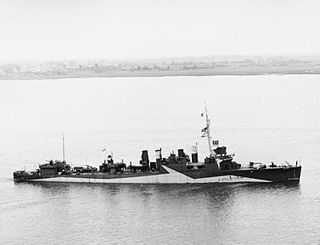
USS Herndon (DD-198) was a Clemson-class destroyer in the United States Navy. Herndon served in the United States Coast Guard as CG-17. She was later transferred to the Royal Navy as HMS Churchill and still later to the Soviet Navy as Deyatelny.

The third USS Decatur (DD-341) was a Clemson-class destroyer in the United States Navy following World War I. She was named for Stephen Decatur.
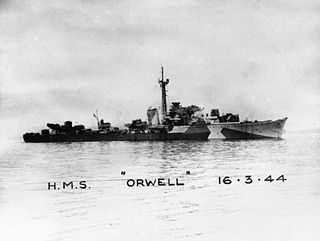
HMS Orwell was an O-class destroyer of the Royal Navy that entered service in 1942 and was broken up in 1965.

USS Brennan (DE-13) was an Evarts-class destroyer escort constructed for the United States Navy during World War II and commissioned in January 1943. She performed anti-submarine and anti-aircraft convoy protection duties in North Atlantic Ocean waters, and was decommissioned in October 1945 at New York Navy Yard and scrapped in 1946.

HMS Wrestler (D35) was a V and W-class destroyer built by the Royal Navy during the First World War and active from 1939 to 1944 during the Second World War. She was the first Royal Navy ship to bear that name, and the only one to do so to date.

Arctic naval operations of World War II were the World War II naval operations that took place in the Arctic Ocean, and can be considered part of the Battle of the Atlantic and/or of the European Theatre of World War II.

HMS Ekins (K552) was a British Captain-class frigate of the Royal Navy that served during World War II. Originally constructed as a United States Navy Buckley class destroyer escort, she served in the Royal Navy from 1943 to 1945.





















